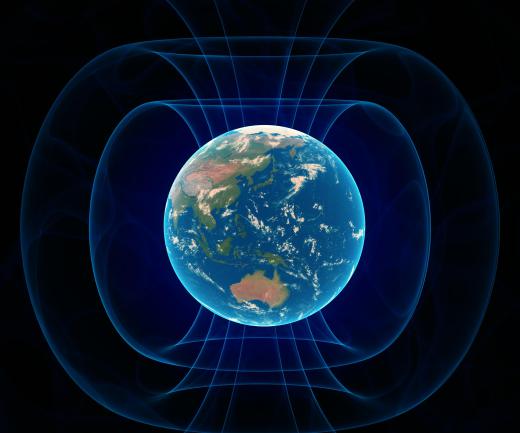What is a Magnetic Storm?
 Michael Anissimov
Michael Anissimov
A magnetic storm is a disturbance in the Earth's magnetic field caused by coronal mass ejections (CMEs) or solar flares from the Sun. It usually begins between 24 and 36 hours after the solar event, when a shock wave of solar wind reaches the Earth's ionosphere. The storm then typically lasts 24 to 48 hours, though some may last as long as days. The effects of such a storm include disruption of communications and navigation systems, intense auroras, damage to satellites, and during the most extreme storms, induced currents in power lines and pipelines that result in power outages and corrosion.
Serious magnetic storms occur once every decade or so, with the most severe occurring once every century. They occur when energetic particles from a solar storm collide with the ionosphere and magnetosphere, creating a cascade of energetic particles and disturbing the atmosphere's magnetic and electric currents. There have been two severe magnetic storms in the last two centuries, including a storm on 28 August - 2 September 1859, which is the largest on record, and another on 13 March 1989.

During the 28 August - 2 September 1859 magnetic storm, auroras were seen as far south as Mexico, Cuba, Hawaii, and Italy. Telegraph wires in Europe and North America shorted out, some causing fires. Active sunspots were observed on the Sun just 18 hours before the shock wave arrived, triggering the geomagnetic storm. This is one of the first times a geomagnetic storm was predicted in advance. The event came to be known as the 1859 solar superstorm.

A more recent magnetic storm, occurring on 13 March 1989, was more damaging to the world's infrastructure due to its greater infrastructure in general, plus increased dependence on sensitive electronics, including satellites. The storm caused the collapse of the Hydro-Québec power grid within a few seconds, when induced currents in the wires blew out transformer cores and fried protective equipment, causing a chain reaction that resulted in power loss for six million people for nine hours and substantial economic damage. The Toronto stock exchange had to temporarily be shut down due to computer damage sustained by the magnetic storm. Several satellites in orbit were damaged for a cost of several tens of millions of dollars.

A magnetic storm could be particularly dangerous for unshielded astronauts, not due to the induced current int he Earth's magnetic field, but by the energetic particles coming directly from the Sun itself. An astronaut in a conventional space suit on the surface of the Moon during a severe storm could receive 7000 rem of radiation, a lethal dose. If the astronaut could be warned and take cover beneath lunar soil, however, the effect would be minimal.
AS FEATURED ON:
AS FEATURED ON:
















Discussion Comments
I wonder if the disruption of radio communications could also affect people with pacemakers?
@anon166484 - I recall reading reports that magnetic storms can cause heart attacks, strokes, problems with blood pressure and change in blood flow. I think the idea is that the extremely low frequency electromagnetic fields can destabilize the heartbeat.
Can a magnetic storm cause health problems?
Post your comments